Future Drought and Flood Vulnerability and Risk Prediction of China’s Agroecosystem under Climate Change
Abstract
:1. Introduction
2. Data and Methods
2.1. Climate Data and Population Data
2.2. Socioeconomic and Agroecological Data
2.3. Methods
2.3.1. Agroecosystem Vulnerability Prediction Model
2.3.2. Combination of AHP and the Entropy Weight Method to Determine the Weight
2.3.3. Agroecosystem Drought and Flood Risk Prediction Model
3. Results and Discussion
3.1. Vulnerability Estimation
3.1.1. Results of the Construction of the Drought Vulnerability Prediction Index System
3.1.2. Drought Vulnerability of China’s Agroecosystem from 2020 to 2050
3.1.3. Construction of the Flood Vulnerability Prediction Index System
3.1.4. Flood Vulnerability of China’s Agroecosystem from 2020 to 2050
3.2. Risk Estimation
3.2.1. Probability of Drought and Flooding in China’s Agroecosystem from 2020 to 2050
3.2.2. The Service Value of China’s Agroecosystem from 2020 to 2050
3.2.3. Drought and Flood Risks in China’s Agroecosystem from 2020 to 2050
4. Conclusions and Discussion
- (1)
- In the next 30 years, as the shared socioeconomic path changes from SSP1-2.6 to SSP5-8.5 in turn, the drought and flood vulnerability of China’s agroecosystem will increase in general, the scope of provinces with high drought vulnerability will gradually expand to the south, and provinces with high flood vulnerability will gradually extend to the southwest.
- (2)
- From 2020 to 2050, the regional distribution pattern of drought risk showed the characteristics of high drought risk in agroecosystems in Northeast, North, Central China, and Southwest China. The flood risk pattern showed the characteristics of high flood risk in the agroecosystem in Northeast, North, Central, East, and Southwest China. As the scenarios changed from SSP1-2.6 to SSP5-8.5 in turn, the number of provinces with high drought risk increased and showed a trend of extending to the south. Under the SSP5-8.5 scenario, the drought risk of the agroecosystem is high, and 60% of the provinces in China have a high risk level of flooding.
- (3)
- It is worth noting that under the SSP5-8.5 scenario, Heilongjiang and Jilin in Northeast China, Henan, Hubei, Anhui, Hunan and Jiangxi in Central China, Inner Mongolia and Hebei in North China, Shandong and Jiangsu in East China, and Sichuan, Yunnan, Guizhou, and Guangxi in Southwest China, the drought and flood risk in the agroecosystem in these provinces will be higher in the next 30 years. Northeast and Central China belong to China’s commodity grain bases. Crops have a long history of planting, and plant growth is easily restricted by drought and floods, resulting in a higher risk of drought and floods in the agroecosystems of Northeast and Central China. These provinces need to strengthen the use of irrigation infrastructure; promote water-saving irrigation technologies, such as sprinkler irrigation and drip irrigation; attach importance to investment; use advanced agricultural machinery and equipment; strengthen soil protection measures; and gradually develop climate-smart agriculture. At the same time, Northeast and Central China should continue to implement policies on drought, flood, and climate change adaptation; make emergency response and preparation for drought and flood risks in terms of equipment, facilities, funds, and technology; and make full use of credit, savings, markets, and other financial instruments to ensure restoration and construction in disaster-affected areas.
- (4)
- The climate in North China is unstable and water resources are in short supply all year round. The supply of water resources mainly depends on China’s South-to-North Water Diversion Project. The precipitation and reservoir capacity in this region cannot meet the regional agricultural and ecological water consumption, but floods caused by heavy rains often occur. According to the data, in July 2021, a heavy rainstorm occurred in the central and northern parts of Henan, resulting in flood disasters that affected 14.786 million people in 150 counties in Henan Province and caused a direct economic loss of 120.06 billion yuan, of which Zhengzhou City was 40.9 billion CNY, accounting for 34.1% of Henan province [57]. East China belongs to the southeastern coastal area, with a low altitude, adjacent to the Bohai Sea and the Yellow Sea, with vertical and horizontal rivers, insufficient freshwater resources, and a high risk of drought and flooding in the agroecosystem. On the one hand, these areas need to pay attention to the regular maintenance of dams, pipelines, and reservoirs for water supply and storage systems. The southwestern provinces of China have complex topography, spanning the three steps of my country’s landforms, with many mountains and ridges, and their altitudes are mostly 4000–5000 m. It is cold in winter and cool in summer, and the distribution of water and heat is uneven [58], so the risk of drought and flood in the agroecosystem is high. These areas need to advocate that farmers can diversify crops in agricultural planting and production activities, adopt intercropping, crop rotation, and other planting methods, select drought-resistant and flood-resistant crops, and adjust planting dates and planting structures. Farmers should adopt diversified livelihood strategies, actively participate in education and training on water conservation, farming methods, drought and flood awareness, and risk management, and apply them to daily agricultural production and life activities.
- (5)
- According to the natural geographical and socio-economic background and characteristics of each province in China, we select indicators such as socio-economic development, agriculture, ecological environment, human activities, and agricultural science and technology. We combine statistics and forecast data from different repositories and establish indicator systems for predicting the vulnerability of the agroecosystem to drought and flood disasters. At the same time, this study uses the combination of AHP and the entropy weighting method to reduce the uncertainty of prediction and enhance the repeatability of this study. In addition, in future research work, a multi-indicator evaluation system can be constructed based on the local natural and human context, which can be applied not only to the agricultural system, ecosystem vulnerability, and risk assessment but also to food security, the economic system, and human health risk assessment work. Moreover, compared with the methods used in other studies such as water scarcity and similar indicator reports, the indicator system constructed in this study involves many fields such as society, nature, climate change, human activities, technological level, economic development, and so on. At the same time, based on the vulnerability and risk assessment of China’s agroecosystem in the past 30 years, a comparative analysis of the vulnerability and risk distribution and characteristics of SSP1-2.6, SSP2-4.5, and SSP5-8.5 in the next 30 years is carried out in order to ensure the coherence and credibility of this research.
- (6)
- In the next step of research, we can consider adding effective actions that farmers and agricultural production cooperatives have taken or may take and conduct adaptive analysis based on relevant driving factors and risk patterns to more accurately formulate and adjust relevant adaptation strategies and reduce ecosystem vulnerability and risk loss. Moreover, in future research, agroecosystem types or large geomorphic units can be used as the basic unit of classification for agroecosystem disaster risk estimation to take into account the influencing factors of different geomorphic units and climatic regions in China.
Supplementary Materials
Author Contributions
Funding
Institutional Review Board Statement
Informed Consent Statement
Data Availability Statement
Conflicts of Interest
Appendix A
| Schema Name | The Institution | Mode Resolution (Longitude × Latitude) |
|---|---|---|
| ACCESS-CM2 | Commonwealth Scientific and Industrial Research Organization of Australia, Australian Research Council Centre of Excellence for Climate System Science | 1.875° × 1.25° |
| ACCESS-ESM1-5 | Commonwealth Scientific and Industrial Research Organization of Australia | 1.875° × 1.25° |
| BCC-CSM2-MR | China National Climate Center | 3.2° × 1.6° |
| FGOALS-g3 | Institute of Atmospheric Physics, Chinese Academy of Sciences | 1.8° × 0.8° |
| CanESM5 | Canadian Centre for Climate Modeling and Analysis | 2.8125° × 2.8125° |
| CanESM5-CanOE | Canadian Centre for Climate Modeling and Analysis | 2.8125° × 2.8125° |
| CNRM-CM | French National Centre for Meteorological Research, European Centre for Computational Research and Advanced Training | 1.4° × 1.4063° |
| CNRM-CM6-1-HR | French National Centre for Meteorological Research, European Centre for Computational Research and Advanced Training | 1.4° × 1.4063° |
| CNRM-ESM | French National Centre for Meteorological Research, European Centre for Computational Research and Advanced Training | 1.4° × 1.4063° |
| IPSL-CM | Pierre Simon Laplace Institute, France | 1.4° × 1.4063° |
| EC-Earth3 | European Centre for Medium-Range Weather Forecasts | 0.7031° × 0.7031° |
| EC-Earth3-Veg | European Centre for Medium-Range Weather Forecasts | 0.7031° × 0.7031° |
| GFDL-ESM4 | NOAA Geohydrodynamics Laboratory | 2.88° × 1.8° |
| GISS-E2-1-G | NASA Gold Institute for Space Studies | 2.88° × 1.8° |
| INM-CM4-8 | Institute of Numerical Mathematics of the Russian Academy of Sciences | 2° × 1.5° |
| INM-CM5-0 | Institute of Numerical Mathematics of the Russian Academy of Sciences | 2° × 1.5° |
| MIROC6 | Japan Marine Earth Science and Technology Agency | 1.4063° × 1.3953° |
| MIROC-ES2L | Japan Marine Earth Science and Technology Agency | 2.8125° × 2.8125° |
| MRI-ESM | Japan Meteorological Institute | 1.125° × 1.125° |
| MPI-ESM1-2-HR | German Max Planck Institute for Meteorology, German Meteorological Office | 0.9375° × 0.9375° |
| MPI-ESM1-2-LR | Max Planck Institute for Meteorology, Alfred Wegener Institute, Germany | 1.875° × 1. 875° |
| UKESM1-O-LL | UK National Centre for Atmospheric Science, UK Met Office Hadley Centre | 3.2° × 1.6° |
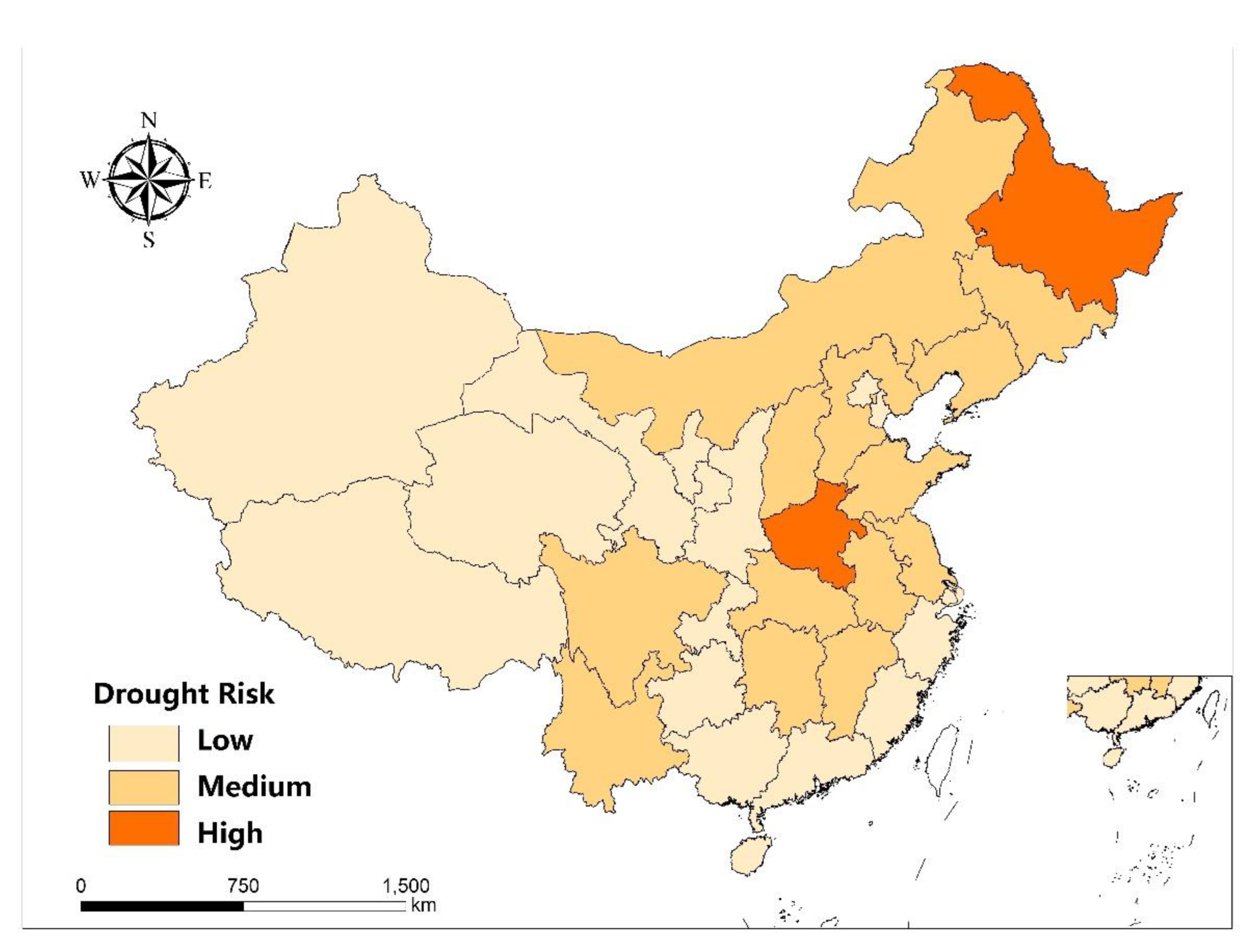
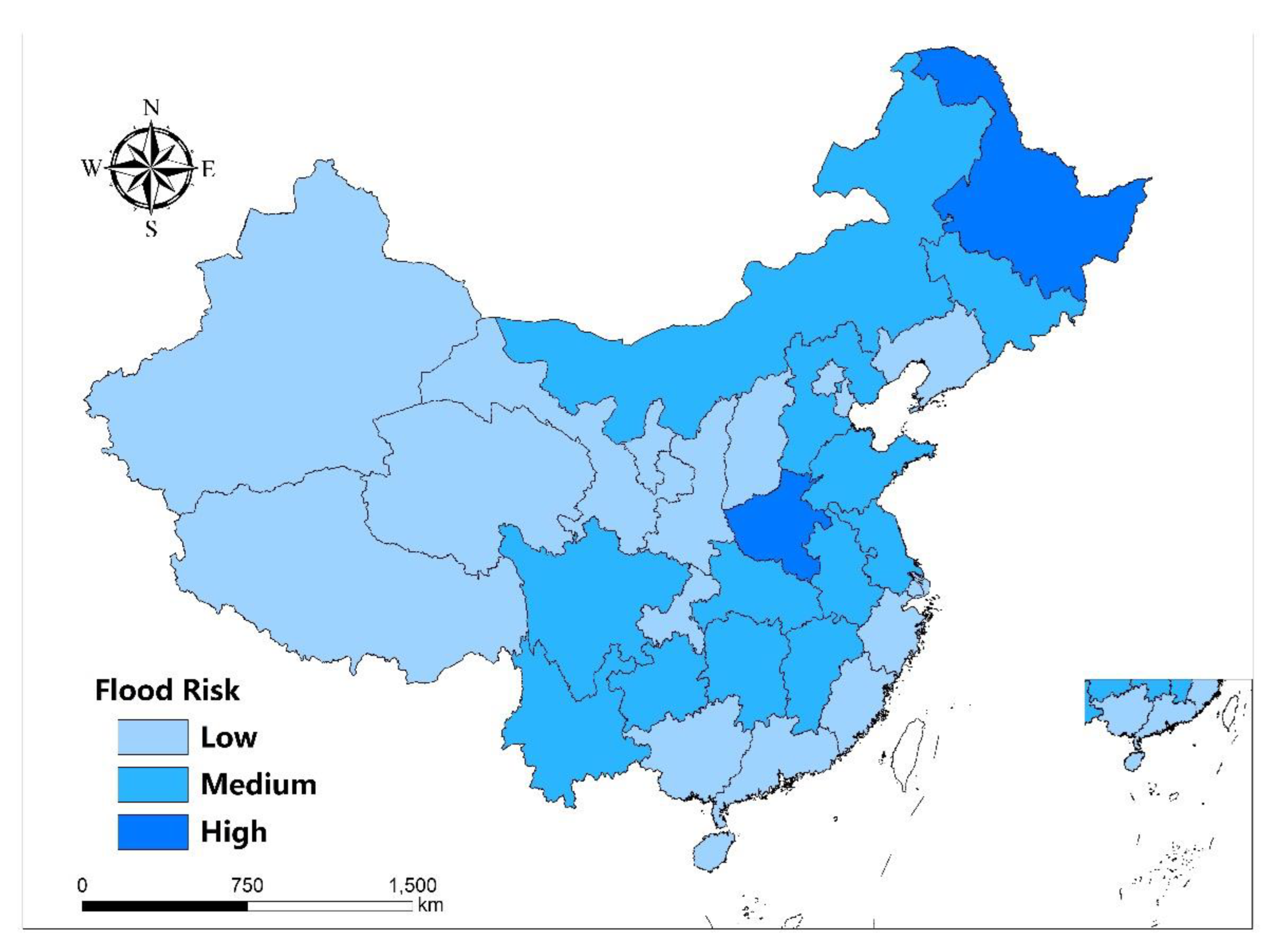
References
- Houghton, J.T.; Jenkins, G.; Ephraums, J.J. (Eds.) The IPCC Scientific Assessment; Cambridge University Press: Cambridge, UK, 1990. [Google Scholar]
- Watson, R.T.; Zinyowera, M.C.; Moss, R.H. (Eds.) Climate Change 1995. Impacts, Adaptations and Mitigation of Climate Change: Scientific-Technical Analyses; Cambridge University Press: Cambridge, UK, 1995. [Google Scholar]
- McCarthy, J.J.; Canziani, O.F.; Leary, N.A.; Dokken, D.J.; White, K.S. (Eds.) Climate Change 2001: Impacts, Adaptation, and Vulnerability: Contribution of Working Group II to the Third Assessment Report of the Intergovernmental Panel on Climate Changes; Cambridge University Press: Cambridge, UK, 2001. [Google Scholar]
- Parry, M.L.; Canziani, O.; Palutikof, J.; Van der Linden, P.; Hanson, C. (Eds.) Climate Change 2007—Impacts, Adaptation and Vulnerability: Working Group II Contribution to the Fourth Assessment Report of the IPCC; Cambridge University Press: Cambridge, UK, 2007. [Google Scholar]
- Pörtner, D.C.; Roberts, M.; Tignor, E.S.; Poloczanska, K.; Mintenbeck, A.; Alegría, M.; Craig, S.; Langsdorf, S.; Löschke, V.; Möller, A.; et al. (Eds.) Climate Change 2022: Impacts, Adaptation, and Vulnerability.Contribution of Working Group II to the Sixth Assessment Report of the Intergovernmental Panel on Climate Change; Cambridge University Press: Cambridge, UK, 2007. [Google Scholar]
- Budiyono, Y.; Aerts, J.; Brinkman, J.J.; Marfai, M.A.; Ward, P. Flood risk assessment for delta mega-cities: A case study of Jakarta. Nat. Hazards 2015, 75, 389–413. [Google Scholar] [CrossRef]
- Wang, H.M.; Chen, J.; Xu, C.Y.; Zhang, J.; Chen, H. A framework to quantify the uncertainty contribution of GCMs over multiple sources in hydrological impacts of climate change. Earth’s Future 2020, 8, e2020EF001602. [Google Scholar] [CrossRef]
- Tanure, T.; Miyajima, D.N.; Magalhaes, A.S.; Domingues, E.P.; Carvalho, T.S. Impacts of Climate Change on Agricultural Production, Land Use and Economy of the Legal Amazon Region between 2030 and 2049. EconomiA 2020, 21, 73–90. [Google Scholar] [CrossRef]
- Simane, B.; Zaitchik, B.F.; Foltz, J.D. Agroecosystem specific climate vulnerability analysis: Application of the livelihood vulnerability index to a tropical highland region. Mitig. Adapt. Strateg. Glob. Chang. 2016, 21, 39–65. [Google Scholar] [CrossRef]
- Vignola, R.; Harvey, C.A.; Bautista-Solis, P.; Avelino, J.; Rapidel, B.; Donatti, C.; Martinez, R. Ecosystem-based adaptation for smallholder farmers: Definitions, opportunities and constraints. Agric. Ecosyst. Environ. 2015, 211, 126–132. [Google Scholar] [CrossRef]
- Epule, T.E.; Ford, J.D.; Lwasa, S. Projections of maize yield vulnerability to droughts and adaptation options in Uganda. Land Use Policy 2017, 65, 154–163. [Google Scholar] [CrossRef]
- Senyolo, M.P.; Long, T.B.; Blok, V.; Omta, O. How the characteristics of innovations impact their adoption: An exploration of climate-smart agricultural innovations in South Africa. J. Clean. Prod. 2018, 172, 3825–3840. [Google Scholar] [CrossRef]
- Ashraf, M.; Arshad, A.; Patel, P.M.; Khan, A.; Qamar, H.; Siti-Sundari, R.; Babar, J.R. Quantifying climate-induced drought risk to livelihood and mitigation actions in Balochistan. Nat. Hazards 2021, 109, 2127–2151. [Google Scholar] [CrossRef]
- Durowoju, O.S.; Ologunorisa, T.E.; Akinbobola, A. Assessing agricultural and hydrological drought vulnerability in a savanna ecological zone of Sub-Saharan Africa. Nat. Hazards 2022, 111, 2431–2458. [Google Scholar] [CrossRef]
- Meza, I.; Siebert, S.; Döll, P.; Kusche, J.; Herbert, C.; Rezaei, E.E.; Nouri, H.; Gerdener, H.; Popat, E.; Frischen, J.; et al. Michael Global-scale drought risk assessment for agricultural systems. Nat. Hazards Earth Syst. Sci. 2020, 20, 695–712. [Google Scholar] [CrossRef]
- Swami, D.; Parthasarathy, D. Dynamics of exposure, sensitivity, adaptive capacity and agricultural vulnerability at district scale for Maharashtra, India. Ecol. Indic. 2021, 121, 107206. [Google Scholar] [CrossRef]
- Zhou, G.S. Prospects for the impact of climate change on agricultural production in China. Meteorol. Environ. Sci. 2015, 38, 80–94. (In Chinese) [Google Scholar]
- Cai, Y.L. Vulnerability and adaptation strategies of Chinese agriculture under global climate change. Acta Geogr. Sin. 1996, 51, 202–212. [Google Scholar]
- Liu, Y.; You, M.; Zhu, J.; Wang, F.; Ran, R. Integrated risk assessment for agricultural drought and flood disasters based on entropy information diffusion theory in the middle and lower reaches of the Yangtze River, China. Int. J. Disaster Risk Reduct. 2019, 38, 101194. [Google Scholar] [CrossRef]
- Xu, Y.L.; Zhao, Y.C.; Zhai, P.M. IPCC Special Report SRCCL New Cognition and Enlightenment on Climate Change and Food Security. Adv. Clim. Chang. Res. 2020, 16, 37–49. (In Chinese) [Google Scholar]
- Wu, S.H.; Zhao, D.S. New Progress in Research on Climate Change Impacts, Risks and Adaptation in China. China Popul. Resour. Environ. 2020, 30, 1–9. (In Chinese) [Google Scholar]
- Shi, W.J.; Wang, M.L.; Liu, Y.T. Crop yield and production responses to climate disasters in china. Sci. Total Environ. 2021, 750, 141147–141194. [Google Scholar] [CrossRef] [PubMed]
- Liu, D.L.; Zuo, H. Statistical downscaling of daily climate variables for climate change impact assessment over New South Wales, Australia. Clim. Chang. 2012, 115, 629–666. [Google Scholar] [CrossRef]
- Huang, J.; Qin, D.; Jiang, T.; Wang, Y.; Feng, Z.; Zhai, J.; Su, B. Effect of fertility policy changes on the population structure and economy of China: From the perspective of the shared socioeconomic pathways. Earth’s Future 2019, 7, 250–265. [Google Scholar] [CrossRef]
- National Bureau of Statistics of the People’s Republic of China. China Statistical Yearbook; China Statistics Press: Beijing, China, 2021. (In Chinese)
- National Bureau of Statistics of the People’s Republic of China. Inventory Results of China’s Forest Resources. Available online: http://forest.ckcest.cn (accessed on 16 June 2022).
- Field, C.B.; Barros, V.R.; Dokken, D.J.; Mach, K.J.; Mastrandea, M.D.; Bilir, T.E.; Chatterjee Ebi, K.L.; Estrada, Y.O.; Genova, R.C. (Eds.) Climate Change 2014: Impacts, Adaptation, and Vulnerability; Cambridge University Press: Cambridge, UK, 2014. [Google Scholar]
- Qin, J.; Ding, Y.J.; Zhao, Q.D.; Wang, S.P.; Chang, Y.P. Assessments on surface water resources and their vulnerability and adaptability in China. Adv. Clim. Chang. Res. 2020, 11, 381–391. [Google Scholar] [CrossRef]
- Schardong, A.; Simonovic, S.P.; Tong, H. Use of quantitative resilience in managing urban infrastructure response to natural hazards. Int. J. Eng. Sci. 2019, 9, 13–25. [Google Scholar] [CrossRef]
- Saaty, T.L. What is the Analytic Hierarchy Process? In Mathematical Models for Decision Support; Springer: Berlin/Heidelberg, Germany, 1988; pp. 109–121. [Google Scholar]
- Alamanos, A.; Mylopoulos, N.; Loukas, A.; Gaitanaros, D. An Integrated Multicriteria Analysis Tool for Evaluating Water Re source Management Strategies. Water 2018, 10, 1795. [Google Scholar] [CrossRef]
- Wu, J.R.; Chen, X.L.; Lu, J.Z. Assessment of Long and Short-Term Flood Risk Using the Multi-Criteria Analysis Model with the AHP-Entropy Method in Poyang Lake Basin. Int. J. Disaster Risk Reduct. 2022, 75, 102968. [Google Scholar] [CrossRef]
- Li, J.N.; Chou, J.M.; Zhao, W.X.; Li, Q.M.; Xu, Y.; Sun, M.Y.; Yang, F. 1991–2019 drought and flood vulnerability assessment of China’s agro-ecosystem. Clim. Environ. Res. 2022, 27, 19–32. (In Chinese) [Google Scholar]
- Wang, Q. Research on the Effect of Tourism Poverty Alleviation in Yecheng County, Xinjiang Based on AHP & Entropy Weight Method. Master’s Thesis, Tarim University, Aral Shehri, China, 2020. (In Chinese). [Google Scholar]
- Xu, X.G.; Yan, L.; Xu, L.F.; Lu, Y.L.; Ma, L.Y. Ecological Risk Assessment of Natural Disasters in China. J. Peking Univ. Chem. Technol. 2011, 47, 901–908. (In Chinese) [Google Scholar]
- GB/T 20481–2017; Grades of Meteorological Drought. Standardization Administration of the People’s Republic of China: Beijing, China, 2017. Available online: https://kns.cnki.net/kcms/detail/detail.aspx?FileName=SCSF00050541&DbName=SCSF (accessed on 16 June 2022).
- Costanza, R.; Arge, R.; Groot, R.; Farber, S.; Grasso, M.; Hannon, B.; Belt, M. The value of the world’s ecosystem services and natural capital. Nature 1997, 387, 253–260. [Google Scholar] [CrossRef]
- Xie, G.D.; Lu, C.X.; Leng, Y.F.; Zheng, D.; Li, S.C. Evaluation of Ecological Assets on the Qinghai-Tibet Plateau. J. Nat. Resour. 2003, 18, 189–196. (In Chinese) [Google Scholar]
- Xu, Y.Q.; Zhou, B.T.; Yu, L.; Shi, Y.; Xu, Y. The spatiotemporal characteristics of future forest ecosystem service value in China under the background of climate change. Chin. J. Ecol. 2018, 38, 1952–1963. (In Chinese) [Google Scholar]
- Chen, Y.B.; Liu, L.J.; Chen, X.L. Forecasting China’s Inflation Rate: A Comparative Analysis Based on LSTM Model and BVAR Model. Res. Financ. Issues 2021, 6, 18–29. (In Chinese) [Google Scholar]
- China Meteorological Administration. High Temperature Warning Signal and Defense Guide [EB/OL]. Available online: http://www.qxkp.net/qxbk/yjxhjfyzn/202103/t20210312_2948454.html (accessed on 3 August 2022).
- Li, B.Z.; Zhou, G.S. Research progress on drought indicators. Chin. J. Ecol. 2014, 34, 1043–1052. (In Chinese) [Google Scholar]
- Chen, D.D.; Zi, T.; Zhang, Y.F. Drought risk assessment during wheat growing period in Sichuan Province based on water gain and loss index. J. Nat. Disasters 2017, 26, 155–163. (In Chinese) [Google Scholar]
- Yan, J. Analysis of Temporal and Spatial Variation Characteristics of Maize Drought in Liaoning Province Based on Crop Water Deficit Index. Master’s Thesis, Shenyang Agricultural University, Shenyang, China, 2018. (In Chinese). [Google Scholar]
- Cao, Y.Q.; Li, L.H.; Lu, J.; Zhang, R.N. Analysis of drought characteristics during maize growth period in Liaoning Province based on SPEI. Chinese. J. Ecol. 2021, 41, 7367–7379. (In Chinese) [Google Scholar]
- Pan, G.F.; Wang, B.F.; Chen, B.; Fang, Z.B.; Zhao, S.S.; Tian, Y.H. Effects of sowing date on yield, growth period and utilization of temperature and light of different types of japonica rice in central and northern Hubei. Crop. J. 2021, 4, 105–111. (In Chinese) [Google Scholar]
- Wang, H.Y.; Gong, Q. Analysis of the abnormal characteristics of precipitation in the growing season of crops in Northeast China. Meteorol. Sci. Technol. 2005, 33, 345–349. (In Chinese) [Google Scholar]
- Zhao, C.Y.; Wang, Y.; Zhang, Y.S.; Yan, X.Y. Changes of climatic conditions during the growing season of crops in Liaoning Province in the past 50 years and their impact on agricultural production. Disaster Sci. 2009, 24, 102–106. (In Chinese) [Google Scholar]
- Chou, J.M.; Dong, W.J.; Feng, G.L. A method to quantitatively assess the impact of climate change on economic output. Sci. Bull. 2011, 10, 21–23. (In Chinese) [Google Scholar]
- Xiong, W.; Holman, I.P.; You, L.Z.; Yang, J.; Wu, W. Impacts of observed growing-season warming trends since 1980 on crop yields in China. Reg. Environ. Chang. 2014, 14, 7–16. [Google Scholar] [CrossRef]
- Xu, G.C.; Kang, M.Y.; He, L.N.; Li, Y.F.; Chen, Y.R. Ecological vulnerability and its research progress. Chin. J. Ecol. 2009, 29, 2578–2588. (In Chinese) [Google Scholar]
- Wu, S.H.; Pan, T.; Liu, Y.H.; Deng, H.Y.; Jiao, K.W.; Lu, Q.; Gao, J.B. China’s comprehensive climate change risk zoning. Acta Geogr. Sin. 2017, 72, 3–17. (In Chinese) [Google Scholar]
- GB/T 28592-2012; Precipitation Level. Standardization Administration of the People’s Republic of China: Beijing, China, 2012. Available online: http://cmastd.cmatc.cn/bzjd/1357.jhtml (accessed on 16 June 2022).
- Xinhua News Agency. Several Opinions of the Central Committee of the Communist Party of China and the State Council on Adhering to Prioritizing the Development of Agriculture and Rural Areas and Doing a Good Job in “Three Rurals”. China Pig Ind. 2019, 14, 17–23. (In Chinese) [Google Scholar]
- Chou, J.M.; Xian, T.; Dong, W.J.; Xu, Y. Regional temporal and spatial trends in drought and flood disasters in China and assessment of economic losses in recent years. Sustainability 2018, 11, 55. [Google Scholar] [CrossRef]
- Shi, B.; Zhu, X.; Hu, Y.; Yang, Y. Drought characteristics of Henan province in 1961–2013 based on Standardized Precipitation Evapotranspiration Index. J. Geogr. Sci. 2017, 27, 311–325. [Google Scholar] [CrossRef]
- The Central People’s Government of the People’s Republic of China. The Investigation Report on the “7.20” Heavy Rainstorm Disaster in Zhengzhou, Henan Announced [EB/OL]. Available online: http://www.gov.cn/xinwen/2022-01/21/content_5669723.htm (accessed on 3 August 2022).
- Jing, J.L.; He, C.X.; Wang, Y.F.; Ma, B.X.; Liu, B. Analysis of temporal and spatial evolution characteristics of drought in South west China from 1902 to 2018. Soil Water Conserv. Res. 2022, 29, 220–227. (In Chinese) [Google Scholar]
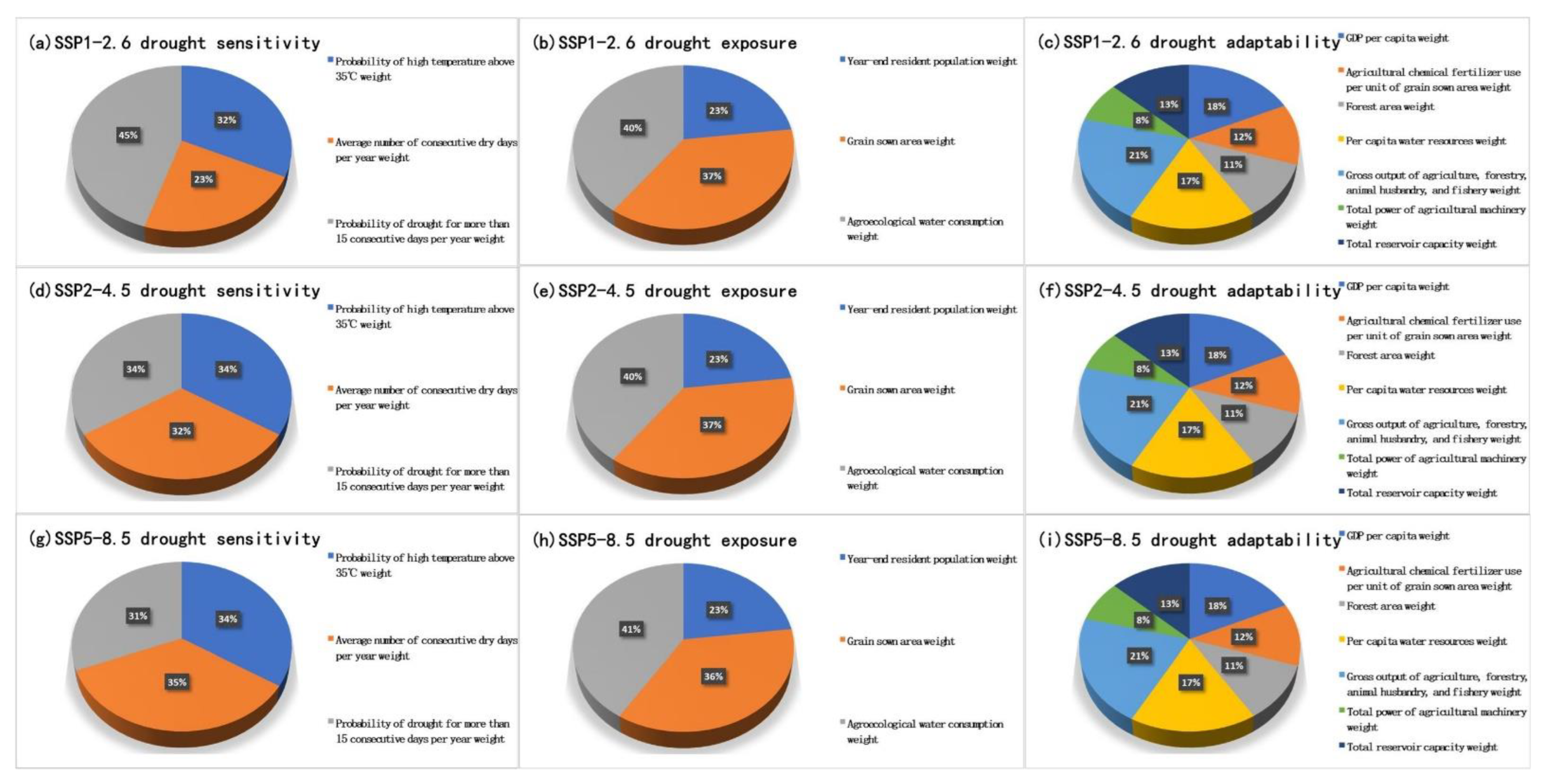
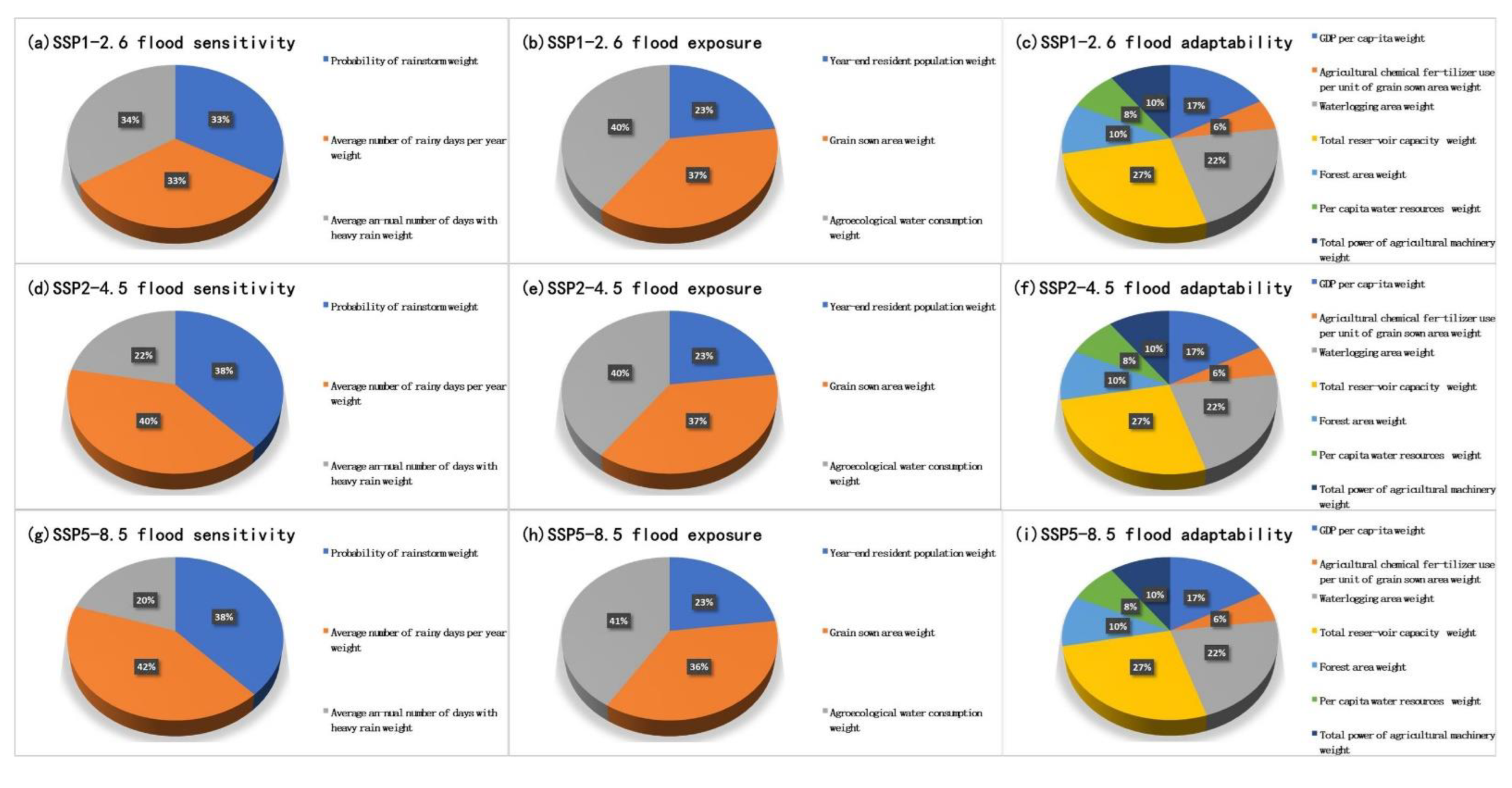
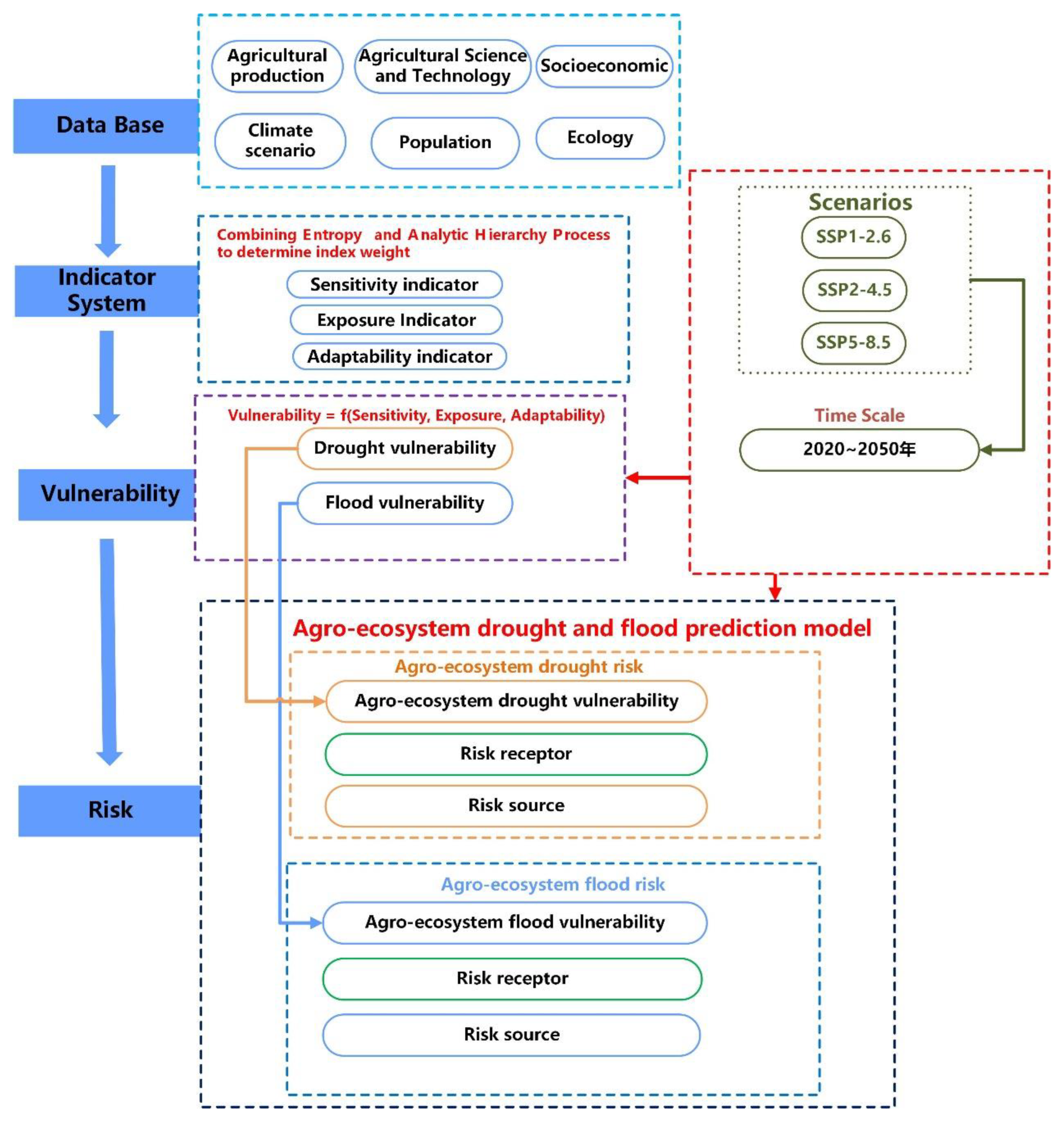
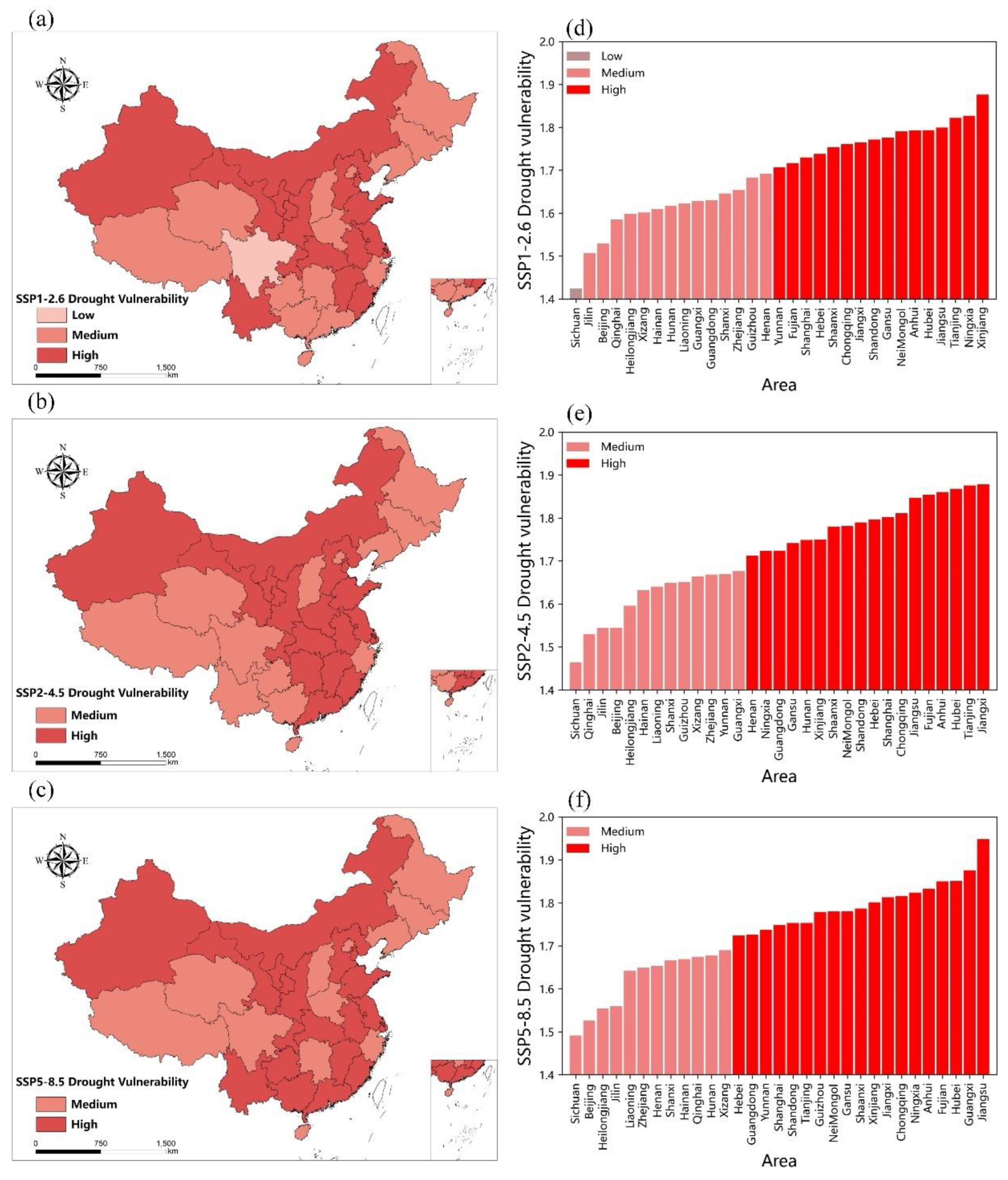
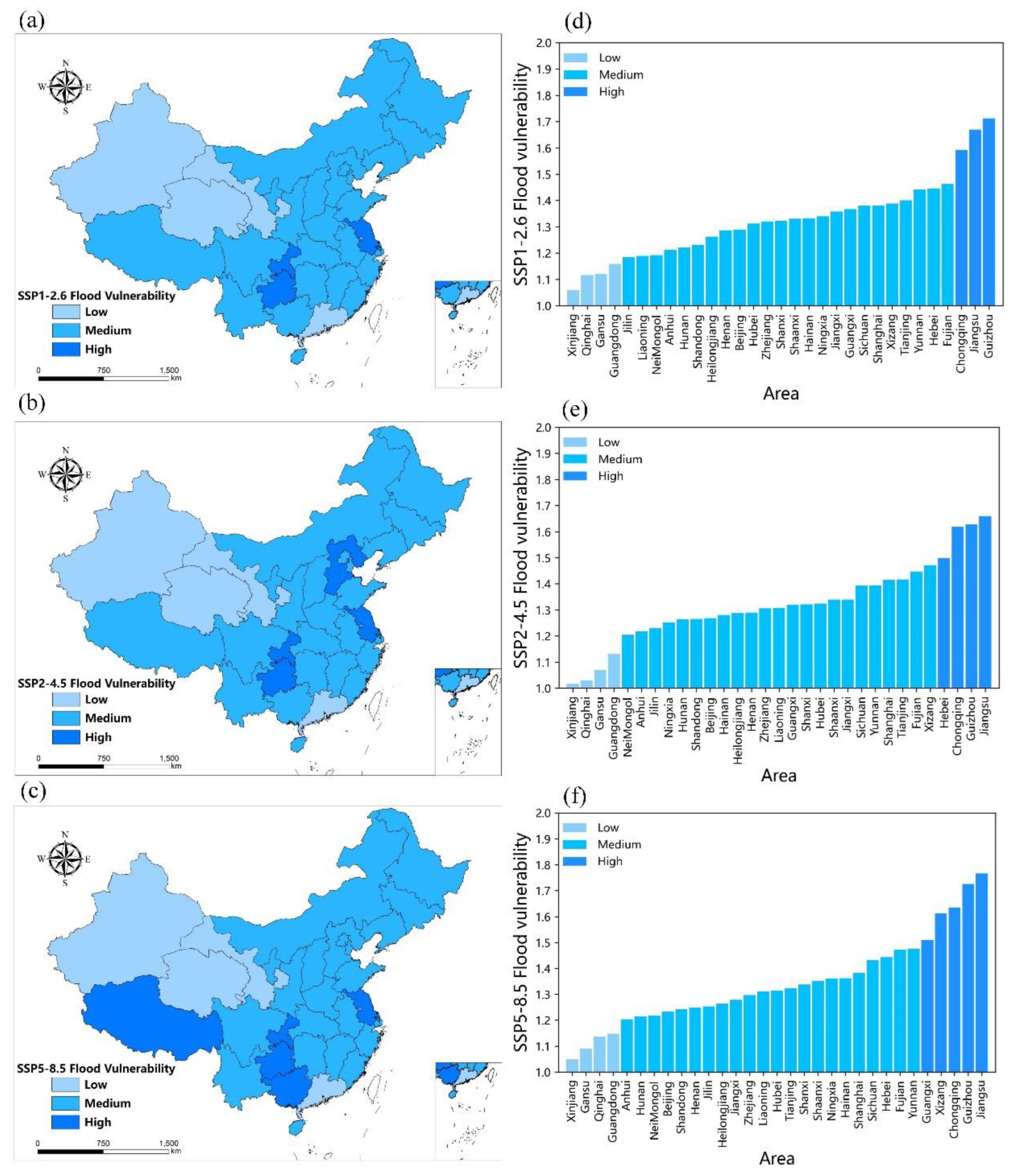
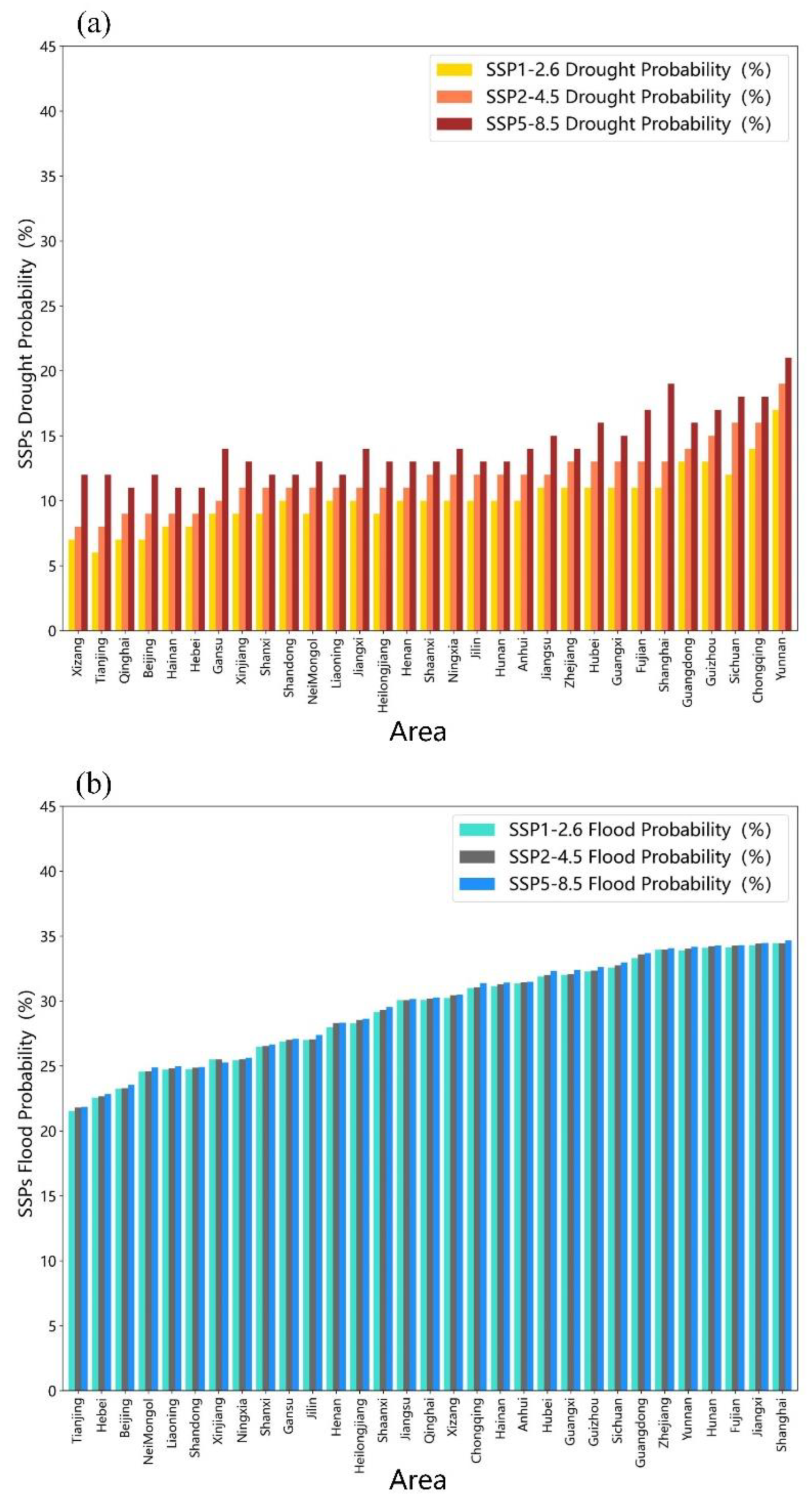

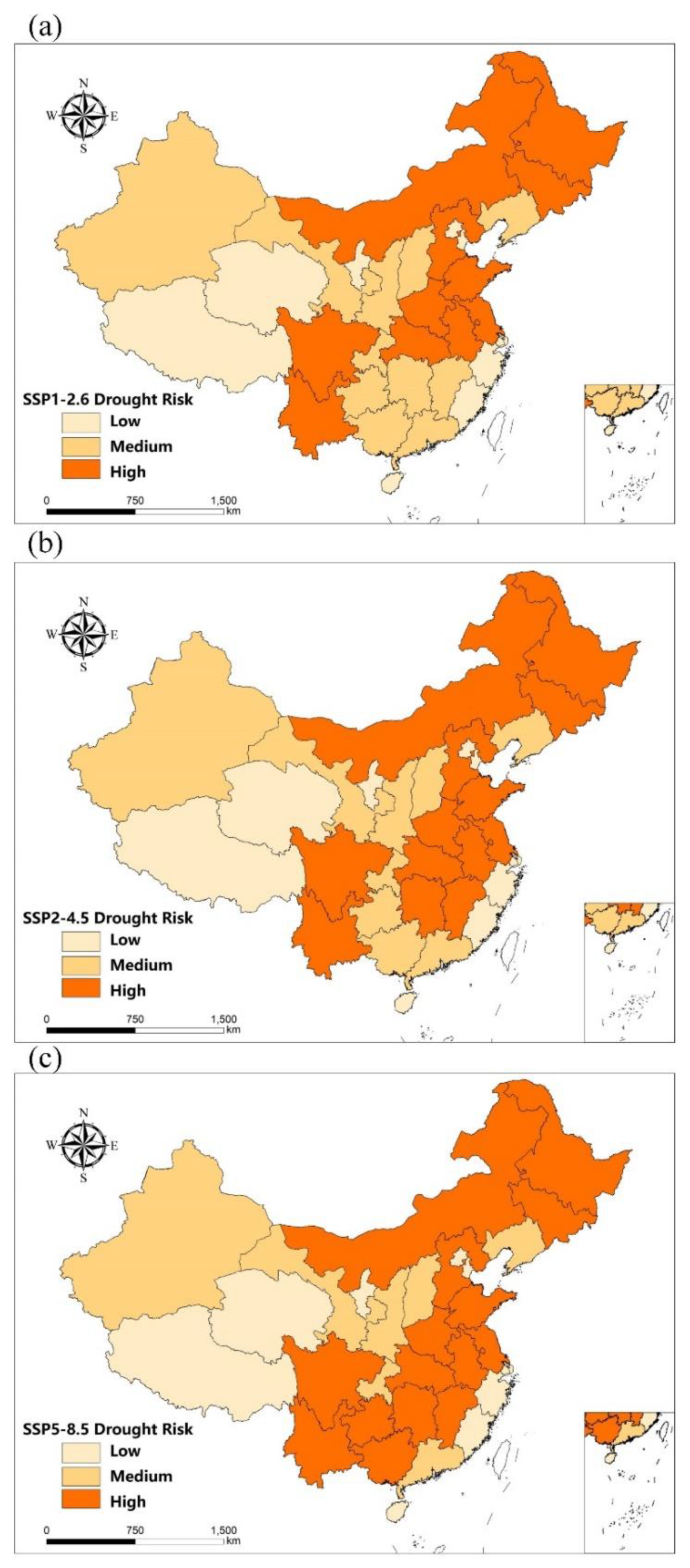

| Target Layer | Criterion Layer | Indicator (Unit) | Indicator Description and Calculation Method |
|---|---|---|---|
| Drought vulnerability of China’s agroecosystem | Sensitivity | Probability of high temperature above 35 °C (%) | Positive indicator. Calculated by dividing the cumulative number of years with the daily maximum temperature ≥35 °C by the total number of years in the desired year |
| Average number of consecutive dry days per year (d) | Positive indicator. According to the standardized precipitation index (SPI) and Meteorological Drought Scale [36]. The number of consecutive drought days refers to the number of consecutive days when the daily SPI reaches moderate drought, severe drought, and extreme drought. The probability of occurrence of drought for more than 15 consecutive days is calculated by dividing the cumulative number of SPI reaching moderate drought, severe drought, and extreme drought for 15 consecutive days or more in the crop growing season from April to September in the desired year by the number of years. | ||
| Probability of drought for more than 15 consecutive days per year (%) | |||
| Exposure | Year-end resident population (104) | Positive indicator. Multidimensional population forecast data under SSP1-2.6, SSP2-4.5, and SSP5-8.5 scenarios from 2020 to 2050 [24]. | |
| Grain sown area (103 hm) | Positive indicator. According to the red line policy of 1.8 billion mu of arable land in China, it is assumed that the sown area of grain will remain unchanged after 2020. | ||
| Agroecological water consumption (109 m3) | Positive indicator. Assuming that the per capita agricultural ecological water consumption from 2020 to 2050 is constant, which is the same as the situation in 2004 to 2019, then the agricultural ecological water consumption from 2020 to 2050 = ∑ (2004 to 2019 per capita agricultural ecological water consumption of each province × annual predicted population of each province). | ||
| Adaptability | GDP per capita (Yuan/person) | Inverse indicator. The adaptability level is assumed to be the same as the drought adaptability status from 1991 to 2019, and the reverse normalized value of the drought adaptability data from 1991 to 2019 is used as the drought adaptability index. | |
| Agricultural chemical fertilizer use per unit of grain sown area (t/hm) | |||
| Forest area (104 hm) | |||
| Per capita water resources (m3/person) | |||
| Gross output of agriculture, forestry, animal husbandry, and fishery (109 yuan) | |||
| Total power of agricultural machinery (104 kW) | |||
| Total reservoir capacity (109 m3) |
| Target Layer | Criterion Layer | Indicator (Unit) | Indicator Description and Calculation Method |
|---|---|---|---|
| Flood vulnerability of China’s agroecosystem | Sensitivity | Probability of rainstorm (%) | Positive indicator. Calculated by dividing the cumulative number of years with daily precipitation ≥50 mm by the total number of years in the desired year *. |
| Average number of rainy days per year (d) | Positive indicator. Calculated by dividing the cumulative number of days with daily precipitation ≥ 50 mm by the number of years in the desired year *. | ||
| Average annual number of days with heavy rain (d) | Positive indicator. Calculated by dividing the cumulative number of days with daily precipitation at (25 mm and 50 mm) by the number of years in the desired year *. | ||
| Exposure | Year-end resident population (104) | Positive indicator. Multidimensional population forecast data under SSP1-2.6, SSP2-4.5, and SSP5-8.5 scenarios from 2020 to 2050 [24]. | |
| Grain sown area (103 hm) | Positive indicator. According to the red line policy of 1.8 billion mu of arable land in China, it is assumed that the sown area of grain will remain unchanged after 2020. | ||
| Agroecological water consumption (109 m3) | Positive indicator. Assuming that the per capita agricultural ecological water consumption from 2020 to 2050 is constant, which is the same as the situation in 2004 to 2019, then the agricultural ecological water consumption from 2020 to 2050 = ∑ (2004 to 2019 per capita agricultural ecological water consumption of each province × annual predicted population of each province). | ||
| Adaptability | GDP per capita (Yuan/person) | Inverse indicator. Adaptability is assumed to be the same as the flood adaptability from 1991 to 2019, and the reverse-standardized value of the flood adaptability data from 1991 to 2019 is used as the flood adaptability index | |
| Agricultural chemical fertilizer use per unit of grain sown area (t/hm) | |||
| Waterlogging area (103 hm) | |||
| Per capita water resources (m3) | |||
| Forest area (104 hm) | |||
| Total power of agricultural machinery (104 kW) | |||
| Total reservoir capacity (109 m3) |
Publisher’s Note: MDPI stays neutral with regard to jurisdictional claims in published maps and institutional affiliations. |
© 2022 by the authors. Licensee MDPI, Basel, Switzerland. This article is an open access article distributed under the terms and conditions of the Creative Commons Attribution (CC BY) license (https://creativecommons.org/licenses/by/4.0/).
Share and Cite
Li, J.; Chou, J.; Zhao, W.; Xu, Y.; Hao, Y.; Li, Y. Future Drought and Flood Vulnerability and Risk Prediction of China’s Agroecosystem under Climate Change. Sustainability 2022, 14, 10069. https://doi.org/10.3390/su141610069
Li J, Chou J, Zhao W, Xu Y, Hao Y, Li Y. Future Drought and Flood Vulnerability and Risk Prediction of China’s Agroecosystem under Climate Change. Sustainability. 2022; 14(16):10069. https://doi.org/10.3390/su141610069
Chicago/Turabian StyleLi, Jiangnan, Jieming Chou, Weixing Zhao, Yuan Xu, Yidan Hao, and Yuanmeng Li. 2022. "Future Drought and Flood Vulnerability and Risk Prediction of China’s Agroecosystem under Climate Change" Sustainability 14, no. 16: 10069. https://doi.org/10.3390/su141610069
APA StyleLi, J., Chou, J., Zhao, W., Xu, Y., Hao, Y., & Li, Y. (2022). Future Drought and Flood Vulnerability and Risk Prediction of China’s Agroecosystem under Climate Change. Sustainability, 14(16), 10069. https://doi.org/10.3390/su141610069






